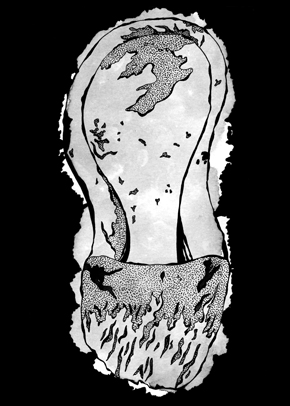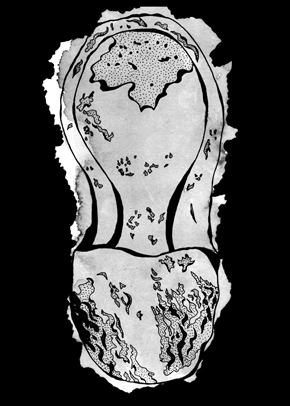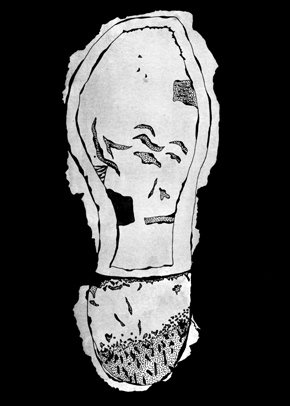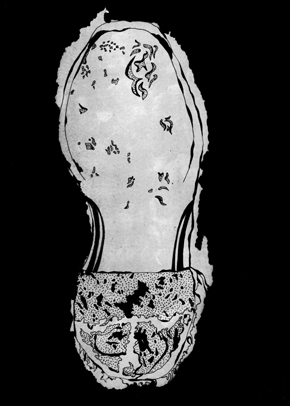Three Hills
Natalie Vestin
Crocus
 Snow, softly. The semiotics of butt marks to gauge whether there’s ice underneath. Snow in three spirals against my face as I walk toward a low awning.
Snow, softly. The semiotics of butt marks to gauge whether there’s ice underneath. Snow in three spirals against my face as I walk toward a low awning.
Winter walk moves upward. Boots hit snow and ice until I’m no longer slipping but instead tilting outward, body side drawn to sidewalk. Compacted snow and rigid concrete striking my sacrum and hip with a loud low ring. It rains and freezes and snows, and the rain collects in the valleys, sheets of ice hidden away until they seep underground and pock the sidewalk with fall-away holes crumbling inward.
A man with his grandson on Milton Street. He smiles; his face can’t help itself. Inside a shop, two women look at greeting cards. Lure of paper, nice things pressed, soft to touch. Outside the shops, the sidewalks are safe and salted. My eyes are distracted. I read this morning about the psychology of geographical slant, or how people feel when they’re walking on hills. It’s harder than walking on a straight plane and also more available to trickery. To relationships between horizon and ground.
The sun is high overhead. It’s midday, though it doesn’t look it because of the hills. Hills distort space, make you think getting somewhere is harder (a curving shortcut) or easier (a sudden drop-off) than it is.
Body is angled. Keep your footing. Keep your eyes on where sky and earth meet. Lean into your butt; don’t arch your back. That’s uphill: obstacle. Lean back. Gaze straight ahead; beware of ice or water-crumbled hole. That’s downhill. Don’t give over to what you want. Don’t tumble-run.
 Wobbling gently from side to side in a conversation on the difference between each patch of ice or snow. Mistrust bareness watch for sparkle. I fit the mounds of snow into my arch, stretched connective tissue, or between the metatarsals, under mound of toe. I rock a little midstride.
Wobbling gently from side to side in a conversation on the difference between each patch of ice or snow. Mistrust bareness watch for sparkle. I fit the mounds of snow into my arch, stretched connective tissue, or between the metatarsals, under mound of toe. I rock a little midstride.
It’s single digits and the elderly come out to walk on Summit Avenue to let their cheeks grow chapped. We boot-skate across the ice floes on sidewalks outside the rich people’s homes. We wonder why we don’t see them, if they are scared of the people who befriend hard mercies.
I’m strong, almost as strong as the old man in the veteran’s cap with the pins and badges, who I passed on the Grotto Street sidewalk as snow whipped our cheekbones, the man who looked at me and said, “Beautiful day.” And it was, and I had a cinnamon roll in my bag because of the falling snow, and I fell a couple of blocks later on my sprained hip ligament, as if the hip is drawn toward what hurts it, toward beauty and injury and what infuriates, and, hell, what can I do about that?
Beautiful day. The infuriating beauty of the ice. Prism, shatter, all the work to heal hip tissue gone in one short fall. Crack of body on ice, the way fat doesn’t cushion because it’s tense with cold. Nothing yields. Our walkers’ hearts grow tender with their own soft warm pinkness. It looks like we’re crying and blushing at once, tender-heartedness pulled out by sub-zero sting, the ache of trying to keep warm. Kindness wrung from exhaustion.
My phone battery dies. I slip in the Lexington Avenue crosswalk outside St. Thomas More, under the gaze of the archangel Michael warily clutching a sword he seems not to want.
The lines of buildings against the sky, the sidewalks and road, a safe mineral wasteland white. As if nothing except the salt could ever have been. Salt cuts the light until the beams fold and change shape, break over and onto, make shadow strange and unhomed. The salt is in the itch of my throat and my burning eyes. It makes patterns like bubbles and strange histology on the Portland Avenue concrete, stamped by foot and paw and melted into intricate hives. It makes one long, white, apocalyptic tide of the street.
 The angel in the garden on Avon Street holds snow in her palm. Snow builds on her shoulders and breasts as the shadow of her wings promises itself to the eaves when the sun falls away. Mysterious light from the bell tower, orange glow around metal clockwork.
The angel in the garden on Avon Street holds snow in her palm. Snow builds on her shoulders and breasts as the shadow of her wings promises itself to the eaves when the sun falls away. Mysterious light from the bell tower, orange glow around metal clockwork.
Up Crocus Hill toward home, houses are closer together, wood siding instead of brick or stone, preserved leaded window-remnants usually in the attics, sides partitioned. Angel doorknockers and rotted roofs. The water main under St. Albans Street: here’s where the street and sidewalk crumble underground together and form their own hills. Brutality of melt. On the north side, ice settles in ponds caught straining for the boulevard. Snowpack accumulates. Awkward hips, always trying to catch and balance what stumbles. A fulcrum righting a machine clumsy with variables.
The worst day of the bitter cold. Sidewalks are flecked with crystals made solid and slippery by the touch of the air. Negative 17 overnight, it’s a little warmer now. Shiny lip-gloss everywhere. Pink on faces, cold makes us happy and pretty. Grey sky though there’s no snow coming. High pressure hovers in threat of press. Cardamom donuts at the bakery on Oxford Street. A loaf of Finnish nisu braided and topped with cubed sugar crystals.
Cathedral
 Step climb step climb, right hip raised then dropping. Lattice of frost become a hardening split and merge into ice. Snow presses downward from the steepest part of Cathedral Hill by the abbey to Mother Teresa of Calcutta Boulevard where settlements of homeless people live in tents on the forested cliffside.
Step climb step climb, right hip raised then dropping. Lattice of frost become a hardening split and merge into ice. Snow presses downward from the steepest part of Cathedral Hill by the abbey to Mother Teresa of Calcutta Boulevard where settlements of homeless people live in tents on the forested cliffside.
Between Interstate 35 and the cathedral’s face: a world you don’t see unless you take the downslope where the snow collects on rusted stairs that sometimes disappear.
Confused stone Petrus cradling his lamb never looks up. Glaring Paulus forces your step uphill stronger.
The police officer on Selby Avenue says you can only go down and gestures toward the steep side of Cathedral Hill, toward the old streetcar line now a narrow sidewalk between the backs of houses. It’s snow- and ice-covered; they’re building a ramp from the mouth of the church to downtown for the Crashed Ice skaters.
They’ll dig up the earth, and, later, it will turn to mud and flow off the sidewalks, create thick pits in the open fields by the abbey and community college, on the hill people use to reach the encampments by the freeway. In the old streetcar path joining Mulberry Street, people scatter things they no longer need: broken-down cardboard, sweatpants, aspirin packets.
Smears of iron and limestone, patched sidewalk where the water ate away. Old orange paint.
Styrofoam squeak-crunch, dendrite neck-break. Flakes hardened and shattered, snow piecemeal.
Ramsey
 I don’t sleep all night, worrying about things I needed to do and worrying about worrying. All that resistance. Friction at my eyelids like a dryer sheet. It rains through the morning’s grey gauze. Percussive, arrhythmic hum of dendrite snow, ice, and water: a glaze. Sidewalks coated with it. Black ice they’ll say to the spin-outs, but on the Kent Street sidewalk, it glitters in the crevices of concrete and stone looking like the brushed glazes my mom uses on almond bread.
I don’t sleep all night, worrying about things I needed to do and worrying about worrying. All that resistance. Friction at my eyelids like a dryer sheet. It rains through the morning’s grey gauze. Percussive, arrhythmic hum of dendrite snow, ice, and water: a glaze. Sidewalks coated with it. Black ice they’ll say to the spin-outs, but on the Kent Street sidewalk, it glitters in the crevices of concrete and stone looking like the brushed glazes my mom uses on almond bread.
Sweet warning. I slip and hold my breath, then decide it’s easier not to resist, and I glide. Friction to a surface introduces unexpected circumstances. I climb ramps with my feet sideways and watch the ground for glossier ice and the purple and green magnesium salt. I forget to look for the sun.
Snow slides off the steep slope of the Antioch Christian Center on Hague Street and piles up on the sidewalk around a winding tunnel of past feet. What’s the opposite of a desire line? What’s drawn toward a shattering? The ground underneath hollowed by heel-glimpses is blue and reflective.
The sidewalks are small frozen lakes as I walk to buy ingredients for French peasant soup and pizza for lunch. But there is more salt, sporadic, blue and purple, and maybe green, though I may be imagining the latter, placing green salt where none was. Dangerous that, overconfident, to imagine friction on a surface that might require a different dream. The cashier says, “Last winter, I fell and heard a crack at the back of my head.” Maybe bone crack or ice crack, maybe a marriage made in brutality, in the way cold makes molecules draw together. Are we being drawn toward? Are we attracting and snapping?
Patience. Part easily with cash for the woman who runs across Dale Street and stammers, pregnant, and, for the woman who wonders if I’m dressed warmly enough then answers, “Not so good I need some food and bus fare” when I ask how she’s doing.
 Once, I walked to the market from the University after being stuck for hours waiting for a bus in the cold. My feet, my hands. On the bus, my heart lost rhythm and wouldn’t regain it; I didn’t want to check, fingers on my neck. I can always pretend everything is fine. Sometimes I think I could lose consciousness or my heart would stop entirely, and I’d still go on pretending. I inserted myself between two large men in puffy jackets at the back of the bus by the heater and I just breathed. At the market, I bought roast chicken and purple cabbage in a little plastic box. With fennel, unexpected. It was so good. I ate it in the bath with two fingers of whiskey.
Once, I walked to the market from the University after being stuck for hours waiting for a bus in the cold. My feet, my hands. On the bus, my heart lost rhythm and wouldn’t regain it; I didn’t want to check, fingers on my neck. I can always pretend everything is fine. Sometimes I think I could lose consciousness or my heart would stop entirely, and I’d still go on pretending. I inserted myself between two large men in puffy jackets at the back of the bus by the heater and I just breathed. At the market, I bought roast chicken and purple cabbage in a little plastic box. With fennel, unexpected. It was so good. I ate it in the bath with two fingers of whiskey.
I make the peasant soup, and potatoes leach their starch into broth. Taste of/against winter. I can never parse of/against. A post this morning from a friend of a friend, her baby has won against heart failure for the third time. How do you fight your own left ventricle, how do you keep score? It snows, and the snow adds traction and sparkle, a low squeaky crunch. Light high overhead wobbles, unbalanced. Three inches and a strong wind. The whole block smells of geraniums. Later: air that tastes deep blue, a nearly full moon, and Aldebaran glowing furious over the neighbor’s high eaves.
Ramsey Hill crests at Arundel Street and then falls into the dish of West St. Paul. Orion on his back, Taurus spiraling downward into the arrow. Aldebaran is so familiar I can’t help but think of it as a friend for the familiarity, as if a friend is an angry eye challenging death right where you’d expected it. Another world’s sun seen in darkness. I rise, as the battle between bull and hunter rises, boots gentle, forced into a swish-hush by the snowy night.
Another crest upward to Overlook Park, where I can see the bowl of Saint Paul formed by forested cliffs of the west and south sides, and by myself. The cupping of city and hill light turns the sky indigo. The cello note of it, string vibrating in belly, taut, pulled tight.
Long line of the Smith Avenue high bridge formed by its lights, river dark and still beneath. River fragile and tenuous under the light.
I lean back to muscle my way up the crest. My boots seek the bare spots instead of snow’s friction, an expectation of the many ways to slide now built into my heel, my edge of foot where the rubber’s torn off to expose white plastic like bone.
I build myself solid, feet on snow, everything worn away but the sound in the air, the change of it, and I think of my grandmother, her ovaries and then later everything turned solid and pain-carrying, her smallness and obscene bones like a curtain obscuring them had been drawn away, too much visible, and here I am butter-thighed and tired, and I can keep walking.
Ice abates, and I take a long stride and a quick pace to keep warm. My cheekbone skin wears away under the wind, the mineral wash in the freezing air. Marks from shovels, bike tires, shoe chains and spikes. Where the shovels skid on morphing snow texture: archaeology of levels and layers. What came before and after and how they met. Snow-shovel grid forms curving ribcage after ribcage veering into the smaller hills. Creation of Eve again and again, daughters’ hearts guarded by shatter-armed sleet and what refuses to wear away.
I’m becoming strong and aware. I can hear things I hadn’t listened to before. All the sounds of snow, of me on snow. Hush and shatter and pack. Whoosh of a mouse faster than sight.
 Natalie Vestin is a writer from Saint Paul, Minnesota. She is the author of “Gomorrah, Baby” (Anchor & Plume, 2017) and “Shine a light, the light won’t pass” (MIEL, 2015). Her essays have appeared in Territory, The Normal School, Prairie Schooner, and elsewhere. She works in infectious disease research at the University of Minnesota.
Natalie Vestin is a writer from Saint Paul, Minnesota. She is the author of “Gomorrah, Baby” (Anchor & Plume, 2017) and “Shine a light, the light won’t pass” (MIEL, 2015). Her essays have appeared in Territory, The Normal School, Prairie Schooner, and elsewhere. She works in infectious disease research at the University of Minnesota.
